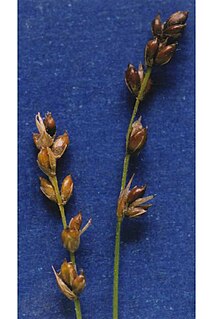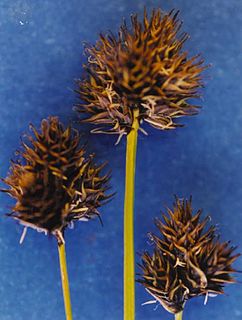Carex amplifolia is a species of sedge known by the common name bigleaf sedge. It is native to western North America from British Columbia to Montana to California, where it grows in wet and seasonally wet areas in coniferous forests.

Carex atherodes is a species of sedge known by the common name wheat sedge. It is native to Eurasia and much of North America including most of Canada and the United States. It is a very common wetland plant across the American Midwest and areas west. It grows in moist and wet habitat, such as marshes and moist prairie land, and it may grow in shallow water. This sedge produces triangular, hollow stems 30 to 120 centimeters tall. The leaves are hairy, especially on the lower parts, and the leaf sheath is tinted with reddish purple. The inflorescence is up to 60 centimeters long and made up of several spikes; those spikes near the tip are usually staminate, and those lower in the inflorescence are usually pistillate. The tip of each fruit has two or more long, thin teeth.

Carex comosa is a species of sedge known as longhair sedge and bristly sedge. It is native to North America, where it grows in western and eastern regions of Canada and the United States, and parts of Mexico. It grows in wet places, including meadows and many types of wetlands. Tolerates deeper water than most common species and is good for retention basins. This sedge produces clumps of triangular stems up to 100 or 120 centimeters tall from short rhizomes. The inflorescence is up to 35 centimeters long and has a long bract which is longer than the spikes. It is a cluster of several cylindrical spikes. The scales over the fruits taper into long, thin awns.

Carex disperma is a species of sedge known by the common names softleaf sedge or two-seed sedge. It is native to much of the northern Northern Hemisphere, from Alaska to Greenland, most of Canada and the contiguous United States, and across Eurasia.

Carex douglasii is a species of sedge known by the common name Douglas' sedge.

Carex haydeniana is a species of sedge known by the common name cloud sedge.

Carex helleri is a species of sedge known by the common name Heller's sedge. It is native to eastern California and western Nevada, where it grows on rocky mountain slopes and in other habitats.

Carex hoodii is a species of sedge known by the common name Hood's sedge. It is native to western North America from Alaska to Nunavut to California to South Dakota, where it grows in dry to moist habitat in forests and on mountain slopes.

Carex illota is a species of sedge known by the common name sheep sedge. It is native to western North America, where it grows in wet places such as marshes and mountain meadows, from New Mexico and California north to Western Canada.

Carex leporinella is a species of sedge known by the common name Sierra hare sedge.

Carex leptalea is a species of sedge known by the common names bristly-stalked sedge and flaccid sedge. It is native to much of North America including most of Canada, the Dominican Republic, and the United States. It only grows in wetlands. This sedge produces dense clusters of thin stems up to 70 centimeters tall from a network of branching rhizomes. The thin, deep green leaves are soft, hairless, and sometimes drooping. The inflorescence is up to 16 millimeters long but only 2 to 3 millimeters wide, and is yellow-green in color. There are only a few perigynia on each spikelet, and they are green and veined.
- Carex leptalea subsp. harperi(Fernald) W.Stone - southeastern US from Texas and Florida north to Missouri and Pennsylvania
- Carex leptalea subsp. leptalea - widespread from Alaska east to Nunavut and south to California and Dominican Republic
- Carex leptalea subsp. pacificaCalder & Roy L.Taylor - Washington State, British Columbia, southeastern Alaska

Carex multicaulis is a species of sedge known by the common name manystem sedge. It is native to California, western Nevada, and southern Oregon, where it grows in chaparral and open forest montane habitats.

Carex nigricans is a species of sedge known by the common name black alpine sedge.

Carex pansa is a species of sedge known by the common name sand dune sedge. It is native to coast of western North America from British Columbia to California, where it grows in dunes and other sandy habitat. This grasslike sedge produces sharply triangular stems up to about 40 centimeters tall from a network of thin, long, coarse rhizomes. The inflorescence is a cluster of several spikes of dark brownish flowers. The plant sometimes produces only male or female flowers in its inflorescences, but not both. This sedge is sometimes used as a grass substitute in local landscaping schemes.
Carex petasata is a species of sedge known by the common name Liddon sedge.

Carex scoparia is a species of sedge known by the common names broom sedge and pointed broom sedge. It should not be confused with the unrelated grass species known as "broom sedge," Andropogon virginicus.

Carex subnigricans is a species of sedge known by the common name nearlyblack sedge.

Carex specuicola is a rare species of sedge known by the common name Navajo sedge. It is native to a small section of the Colorado Plateau in the United States, its distribution straddling the border between Utah and Arizona, and completely within the Navajo Nation. There are several populations but they are limited to a specific type of habitat. The plants grow from the sides of steep, often vertical cliffs of red Navajo Sandstone, in areas where water trickles from the rock. It occurs at elevations between 5,700 and 6,000 feet, usually in shady spots. Though it is not a grass, the sedge grows in inconspicuous clumps resembling tufts of grass sticking out of the rock face. When the sedge was federally listed as a threatened species in 1985, it was known from only three populations in Coconino County, Arizona, with no more than 700 plants existing. The species has since been observed in northeastern Arizona and San Juan County, Utah.

Carex concinna is a species of sedge known by the common names low northern sedge, northern elegant sedge, beauty sedge, and beautiful sedge. It is native to northern North America, where it occurs across Canada and in high elevations in the northern contiguous United States.
Carex garberi is a species of sedge known by the common names elk sedge and Garber's sedge native to North America.
This page is based on this
Wikipedia article Text is available under the
CC BY-SA 4.0 license; additional terms may apply.
Images, videos and audio are available under their respective licenses.

















